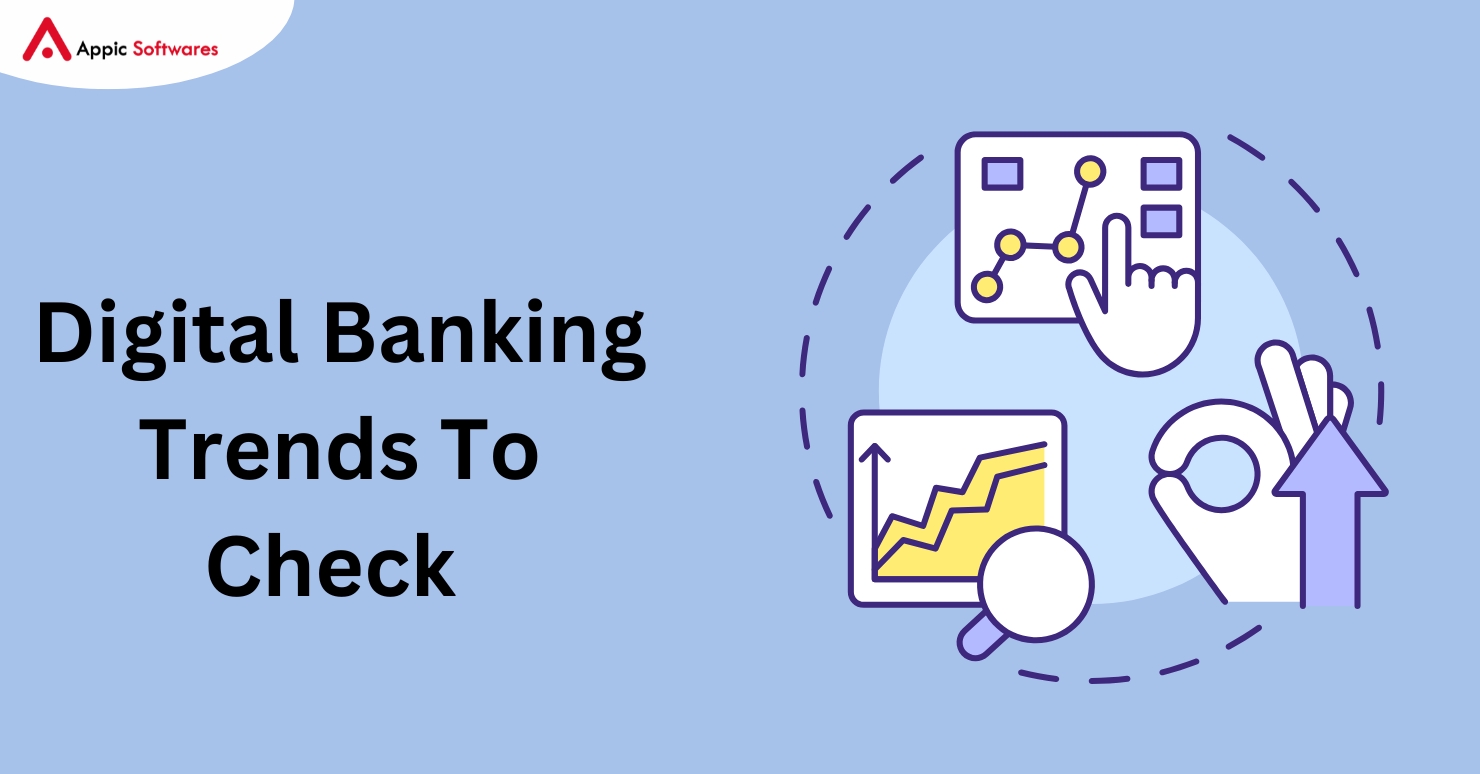
Future banking sector developments will be shaped by digital business models. Customer preferences and behavior are already changing as a result of digitalization in many traditional financial services. Traditional service providers are now facing increased competition as a result of the digital transformation. Financial institutions are facing mounting demands to shift towards becoming ‘digital first’ enterprises to maintain their competitiveness.
By 2024, a lot of banks will have changed into pure technology businesses that use their vast customer bases and wide distribution networks to provide digital solutions.
Which technological developments in digital banking will influence how banking will transform in the future? These are our forecasts:
1. A greater number of customers will favor digital channels over contact ones.
As they select a financial provider, more and more customers are giving priority to digital solutions. They prefer to use digital channels (like online and mobile banking) over contact channels (like in-branch or phone banking), in addition to wanting to see what products they offer.
Shortly, as this trend toward digital banking picks up steam, many banks will find themselves forced to close off large portions of their branch networks as their “digital maturity” advances.
2. Banking is becoming an experience-oriented industry
Financial services providers anticipate that in the future, customer experience will play a major role in differentiating their brands and drawing in new and returning clients.
During their digital transformation, many banks place a high priority on the customer experience, making sure that the solutions they design will satisfy all of the needs of their clients in terms of comfort, convenience, security, and engagement.
Consumers are already anticipating more tailored offers, such as those that leverage their preferences and feedback to create a service that is even more convenient for them. By 2024, the capacity to anticipate client needs and deliver excellent customer experiences will set banks apart from their competitors.
Applying advanced analytics to customer experience increases service quality and lowers expenses. With the help of advanced analytics, banks will soon have such a better understanding of their clientele that they will be able to anticipate demands, enhance service quality, and tailor offers accordingly.
Banks cannot afford to fall behind in the current trend of digital banking. They must reposition themselves as customer-focused organizations that can encourage devoted patrons and reciprocate with business.
3. Open banking amps up the competitive pressures
Although open API banking is still in its infancy, it has the potential to completely change the banking industry. Banks can exchange data with “fintechs,” or third-party service providers, through open APIs. Through digital platforms, these apps are facilitating transactions that are simpler, quicker, and more secure.
Several forward-thinking US and European banks have already implemented Open Banking APIs, with remarkable outcomes. With the increasing blurring of lines between banking and other financial services providers, banks will find that APIs are a useful tool for opening up new avenues for cross-selling transactions or products.
It is anticipated that open APIs will make it easier for clients, third-party service providers, and financial institutions to share data. Better customer experiences and quicker innovation for banks and their clients may arise from the ensuing integration.
Open APIs will face significant security challenges, though, since financial institutions must make sure they can protect customer data as much as necessary without impeding API workflow. For instance, requiring laborious manual verification steps throughout the API process might call for extra security precautions to thwart hacking.
By 2024, banks and other third-party providers will probably still favor open APIs. To prevent third parties from accessing their data, developers might find it advantageous to concentrate on closed or hybrid APIs. It is anticipated that closer cooperation between developers and financial institutions will enable both parties to identify the most effective strategy for combining their technologies.
4. AI-powered chatbots and virtual assistants will improve banking
By 2024, a lot of banks will have changed into pure technology businesses that use their vast customer bases and wide distribution networks to provide digital solutions. Banks can’t compete with pure technology companies that can process massive amounts of data and have access to advanced analytics, even in areas like fraud detection and compliance.
Natural language processing will be standard for consumer communications by 2024. Although chatbots and virtual assistants are already causing waves in many industries, their adaptability is what makes them so valuable in the banking sector.
Banks ought to consider utilizing this technology to offer outstanding customer service. They can lower call center traffic, give consumers automated responses to frequently asked questions, and free up employee time for more important work. These features will be standard in banking apps on the majority of devices, including tablets and smartphones, by 2024.
Approximately ten banks have already launched their chatbots as of right now. Banking chatbots have been extremely popular in China, where many banks are utilizing them for daily transactions.
For its online platform, HDFC Bank in India tested a virtual assistant as a way to better meet the needs and preferences of its customers. It was perceived as an attempt to improve customers’ digital experiences. The virtual assistant offered by Spanish bank BBVA has proved to be extremely popular among younger consumers in Latin America.
5. A new round of competition will result from digital transformation.
Peer-to-peer (P2P) lending platforms, digital wealth management tools, and robo-advisors are just a few of the new players that have emerged as a result of the traditional financial services providers’ digital transformation. The open banking APIs, which let users easily manage multiple accounts via digital self-service channels, have helped these initiatives.
Fintech businesses were among the first to implement digital innovation in a variety of fields, including lending, money transfers, and payments. As they grow their clientele and services, many of these startups are now fierce rivals to banks.
To support their digital transformation efforts and stay competitive with startups that are successfully upending the banking sector, banks are already collaborating with fintech firms.
6. More people will feel comfortable banking on their own
The banking sector is moving toward a more customer-focused model. Customers want experiences that are more tailored to them and give them more independence.
Many self-service options (like mobile account opening) will be offered at a bank branch or ATM near you as digital transformation advances, allowing users to open accounts swiftly and conveniently without having to visit the branch.
The emergence of digital banking is transforming retail banking as it exists today. Through improved self-service features, quicker account opening, safer transactions, and increased transaction accessibility, it’s improving the customer experience.
Through the cross-selling of financial products, banks have been able to create new revenue streams as a result of the increase in customer engagement. Making banking convenient for consumers to enable them to easily accomplish their goals is the core of digital transformation.
By 2024, it is anticipated that automated procedures will revolutionize the quality of service, with self-service technologies driven by cutting-edge analytics enabling clients to make decisions more quickly and intelligently.
7. Focus on Big Data and analytics
Banks will be able to base their business models entirely on the behavior of their customers thanks to big data. By utilizing predictive analytics to its full potential, they can increase sales and offer more individualized services.
The degree to which a bank can learn from its customers will determine how successful its digital transformation will be in the future. Analytics will become indispensable for market segmentation, cross-selling, and customer acquisition initiatives.
Banks will therefore have more knowledge about the spending and behavior patterns of their customers, which will enable them to create more specialized goods and services.
Anticipate seeing more “closed-loop” solutions driven by quick and easy data collection by 2024. By doing this, banks will be able to obtain a comprehensive understanding of the needs of their clientele and present them with offers or discounts that are tailored to their specific situation.
8. Banking applications are evolving into intelligent consumer digital assistants.
By 2024, self-service banking apps will give way to customer relationship management systems that anticipate users’ needs and offer tailored recommendations based on their financial circumstances.
With time, the banking app will develop into a “smart digital assistant” that can “understand” the needs and preferences of the user based on their financial behavior. The smart app will be able to forecast that you will require money for your card soon, for instance, if you consistently transfer money to your savings account on payday but neglect to top off your payment card with funds for the upcoming month.
By speaking with the client and making suggestions for what they might want to do before they even realize it themselves, the astute assistant acts proactively.
9. Blockchain is here to stay, but it needs time to mature
Blockchain technology has a lot of potential for operations and customer experience.
Blockchain technology will be widely used in financial services in 2024, going beyond straightforward transactions and money transfers.
Blockchain for due diligence and KYC
Blockchain technology will be used more frequently for KYC and customer due diligence. By 2024, it’s anticipated that financial institutions will be using decentralized platforms for their KYC and customer due diligence procedures due to the widespread adoption of digital identities.
It is anticipated that these platforms will store customer data on distributed ledgers, which will allow for better data security procedures, cheaper data storage costs, and more efficient identity verification during know-your-customer (KYC) checks.
Securities issuance, trading, and settlement
Blockchain technology is anticipated to be utilized in 2024 for securities issuance, trading, and settlement. This will be made possible by new securities laws, which will permit tokenized assets to be used in conventional financial markets.
Blockchain-driven transaction handling
the creation of platforms for transaction processing based on blockchain technology. It is anticipated that the market will have access to an increased number of blockchain-based transaction processing platforms by 2024. But rather than taking the place of current settlement systems, blockchain-based transaction processing platforms will be seen as an enhancement.
the expansion of digital currencies based on blockchain technology.
It is anticipated that as more companies attempt to enter the market in 2024, there will be a greater need for regulatory cooperation and standardization. The partnership will work to develop a legal structure that will allow digital currencies based on blockchain technology to coexist with more conventional money that is issued by central banks.
10. Banks deepen their customer relationships through AI and chatbots
Chatbots powered by AI will be able to respond to a wide range of queries. A chatbot might be designed, for instance, to access a user’s financial information and recommend products that would be useful to them, like a new savings account or an upgrade on their existing credit card.
AI is more than just chatbots. Other artificial intelligence (AI) applications that banks are investigating include “digital twins,” which are computerized representations of real bank branches that clients are unable to visit, and virtual assistants, which can respond to client requests via text or voice chats.
AI technologies will probably be extensively utilized in the finance industry by 2024. Most financial institutions will have established well-thought-out plans for integrating the technology into their businesses, and many will have even started testing different applications.
11. Platforms for low-code/no-code development to accelerate time to market
Development projects that move slowly are no longer accepted. The banking sector is witnessing a shift towards expedited time to market, as low-code/no-code development platforms enable banks to create digital products with speed and efficiency.
We anticipate that low-code and no-code development platforms will be widely used in banking by 2024 for several reasons.
(1) The time it takes banks to launch digital goods and services will need to be greatly accelerated;
(2) a sharp rise in independent fintech companies that provide ready-made digital products that are simple to incorporate with main banking systems;
(3) A lack of qualified workers with experience in application development.
Platforms with little or no code have developed to the point where they can accommodate the creation of numerous fintech products. Additionally, they provide banks and other businesses with a “simple” means of creating new digital goods and services without needing to shell out large sums of money for expensive application specialists.
These are the 11 digital banking trends that are most likely to have an impact on how people conduct banking in 2024. Customers will have much less difficulty obtaining various banking services in the next five years than they did in the past. The client experience will be entirely different from what is currently provided.
Conclusion
Transformative trends like blockchain and AI personalization, which point to a shift toward improved user experiences and cutting-edge financial services, will define the digital banking landscape in 2024.
Fintech is always changing, and making an app like an e-wallet requires a lot of careful planning and the newest technology. Using Appic Softwares as a guide gives you a strategy plan to get through the tough parts, which encourages innovation and makes it possible to create groundbreaking fintech apps in 2024 and beyond.
So, What Are You Waiting For?








